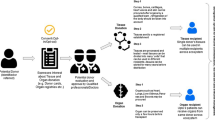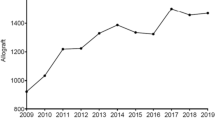Abstract
EU directive 2006/17/EC requires that all available medical information, including the autopsy report, is evaluated before releasing tissues for transplantation. The study objective was to investigate whether evaluation of autopsy results of musculoskeletal tissue donors contributes to safety and availability of transplantable tissues. The files of all donors of whom musculoskeletal tissues were retrieved by BIS in 2006 were reviewed for death cause and autopsy results. Of 84 donors musculoskeletal tissues were retrieved. In 47 donors autopsy was performed (56.0%). The groups with and without autopsy were similar in sex, age, length, and weight. In one donor no autopsy results were evaluated, since the donor was already rejected because of positive blood tests. In 13 donors (28.1%) death causes before autopsy were unknown. In 12 of these donors a death cause could be established after autopsy. In nine of the donors with a clear suspected death cause (27.3%), the death cause after autopsy differed from the suspected death cause. Four donors with autopsy (8.7%) had a general contraindication for donation, a (possible) sepsis in three and a persisting unknown death cause in one. Eight donors (17.4%) had musculoskeletal-specific contraindications, i.e. local infections. In conclusion, in 26.1% of the donors with autopsy, general or musculoskeletal-specific contraindications for donation were found. Furthermore, performance of autopsies enlarges the potential donor pool, since death causes can be established in almost all autopsies done in case of an unknown death cause. Therefore, evaluation of autopsy results improves the safety and quantity of tissues for transplantation.

Similar content being viewed by others
References
Aalten CM, Samson MM, Jansen PA (2006) Diagnostic errors; the need to have autopsies. Neth J Med 64:186–190
Lardenoye JH, Kastelijn KW, van Esch L, Vrancken Peeters MP, Breslau PJ (2005) Evaluation of the rate of autopsy and the rate of disparity between autopsy results and the clinical cause of death in a surgical ward, with the emphasis on necrological review. Ned Tijdschr Geneeskd 149:1579–1583
Peters RP, van Agtmael MA, Danner SA, Savelkoul PH, Vandenbroucke-Grauls CM (2004) New developments in the diagnosis of bloodstream infections. Lancet Infect Dis 4:751–760
Weinstein MP (2003) Blood culture contamination: persisting problems and partial progress. J Clin Microbiol 24:584–602
Author information
Authors and Affiliations
Corresponding author
Rights and permissions
About this article
Cite this article
Van Wijk, M.J., Visser, L. & Bokhorst, A.G. Evaluation of the autopsy report before releasing musculoskeletal tissue donors; what is the benefit?. Cell Tissue Bank 9, 329–335 (2008). https://doi.org/10.1007/s10561-008-9072-5
Received:
Accepted:
Published:
Issue Date:
DOI: https://doi.org/10.1007/s10561-008-9072-5




